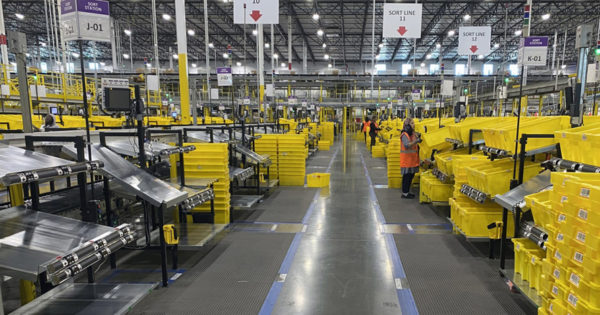In an email to sellers, Amazon said the limitations it imposed on the products it will accept at its warehouses will extend beyond its original estimate of April 5, but it is broadening the list of goods it will accept “on an item-by-item basis.”
The email from its Fulfillment by Amazon (FBA) unit, which was reviewed by Adweek, said Amazon will “regularly update” the list to allow sellers to check which products are eligible to ship as its capacity to receive products grows. (FBA is the program that allows sellers to ship their products to Amazon in advance, so the ecommerce giant can ship those items directly to customers.)
“We consider many factors when determining eligibility, including high-demand products customers need now; current inventory levels and inventory in transit; fulfillment center capacity; and our ability to adhere to the latest health guidelines,” Amazon added in the email, which sellers received late last week.
In a message to sellers on March 17, Amazon said it was prioritizing household staples, medical supplies and other high-demand products in its U.S. and E.U. marketplaces until at least April 5.
“Due to the massive amount of space required to warehouse their products, Amazon relies on fast-turning inventory, meaning that they usually replenish inventories on a weekly cadence,” said an agency executive who asked not to be named because he is not authorized to speak on the record. “Turning off the supply for several weeks meant that Amazon would run out of stock for many non-essential products—and the suppliers of those products missed out on sales.”
This change, however, is a sign Amazon has some capacity again, but only for the top-selling products they need to replenish.
This executive said the biggest challenge for sellers has been lack of communication from Amazon.
“It is definitely a wake-up call for some businesses that were heavily dependent on Amazon.”
“There was little or no warning of the restrictions and there was similarly scant information available on what exactly was restricted or not,” he added.
Jonathan Weber, a seller focused on products like outdoor equipment and office supplies, agreed, noting the update from Amazon means some products the platform deems non-essential could be restricted “for a significant amount of time into the future.”
Similarly, John Frigo, who sells home goods and gadgets, pointed to lack of clarity about exactly how Amazon defines “essential.”
“Initially, the announcement was no inbound shipments of non-essentials,” he said. “Then Amazon started having 30-day delivery dates for non-essentials, which even extended to things like vitamin C, which surprised me. I would think that would fall into the category of medical or essential.”
These sellers, which Amazon CEO Jeff Bezos noted were responsible for 58% of sales in 2018, have taken slightly different approaches to the changes.
Frigo, for example, said he tends to keep a lot of stock with Amazon, so he’ll be okay until mid- to late April—and even until June for some of this products.
Deneiro Bartolini, an Amazon seller with products in categories like kitchenware, baby and mobile accessories, said he usually accounts for a month of extra inventory.
“I typically send stuff to fulfillment centers about every three months. However, most sellers do it more frequently,” Frigo said. “I don’t mind paying a little more in storage fees for the convenience of not having to order frequently.”
Amazon charges sellers fees for the products they store. In an email on March 30, Amazon told sellers it is waiving two weeks of storage fees in March for products stored in the U.S., U.K., Germany, France, Italy, Spain, Poland, the Czech Republic and Canada.
As a result, Amazon sellers with products with shorter lead times may get hit the hardest, Bartolini said. That includes products assembled with pre-made parts or easily assembled on the spot, like screen protectors or small toys.























